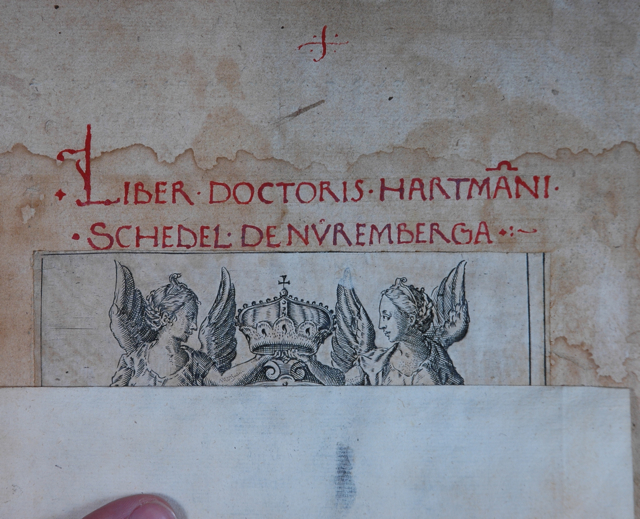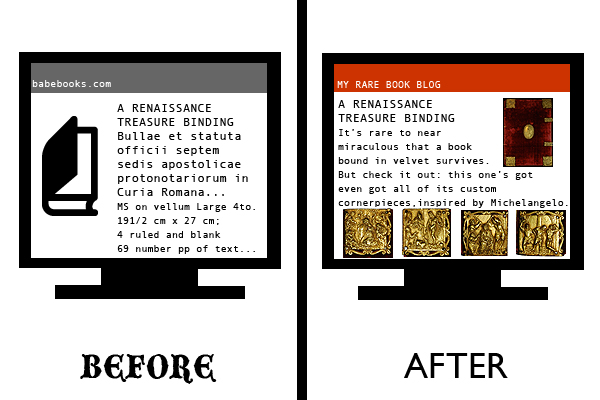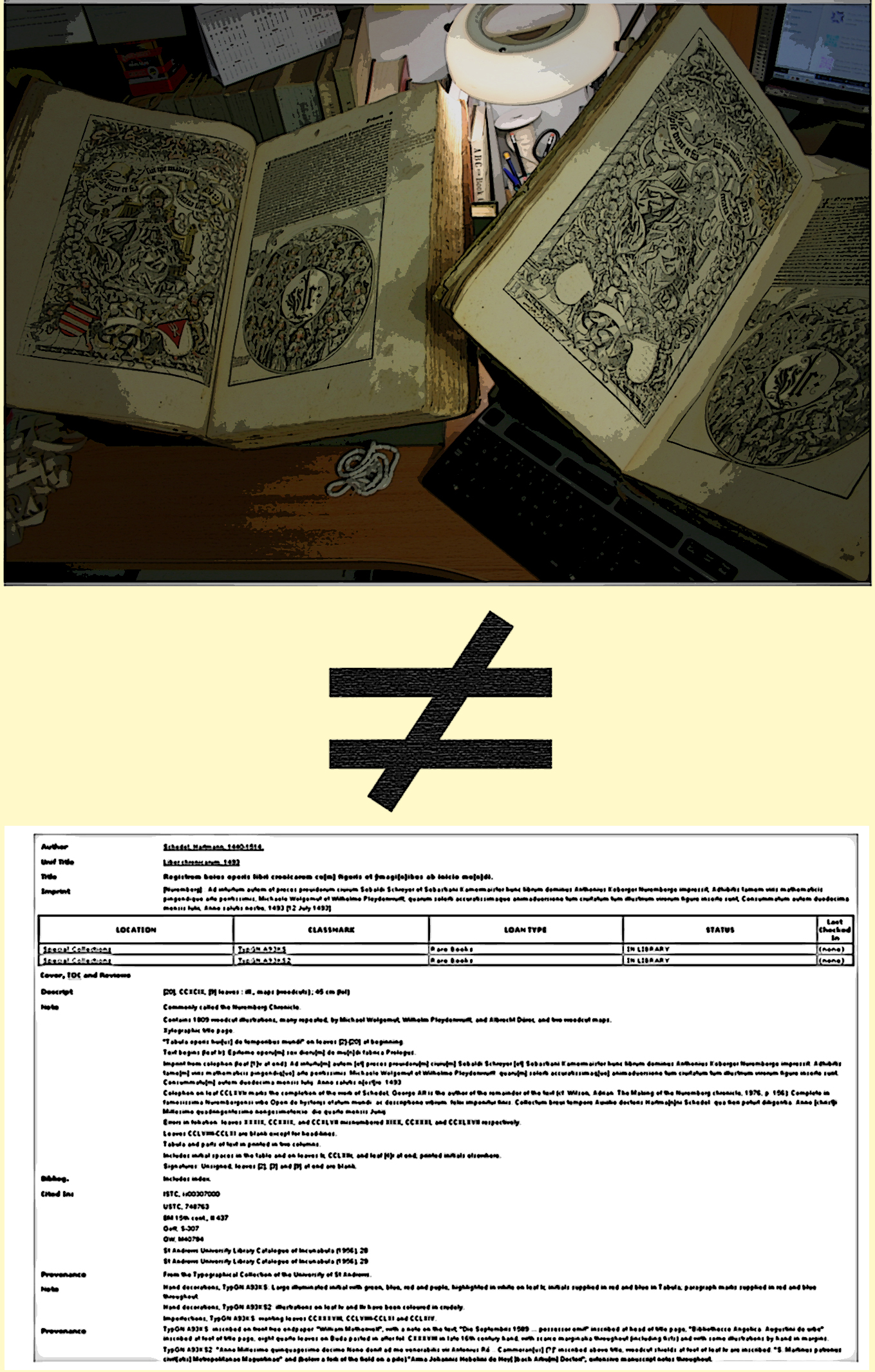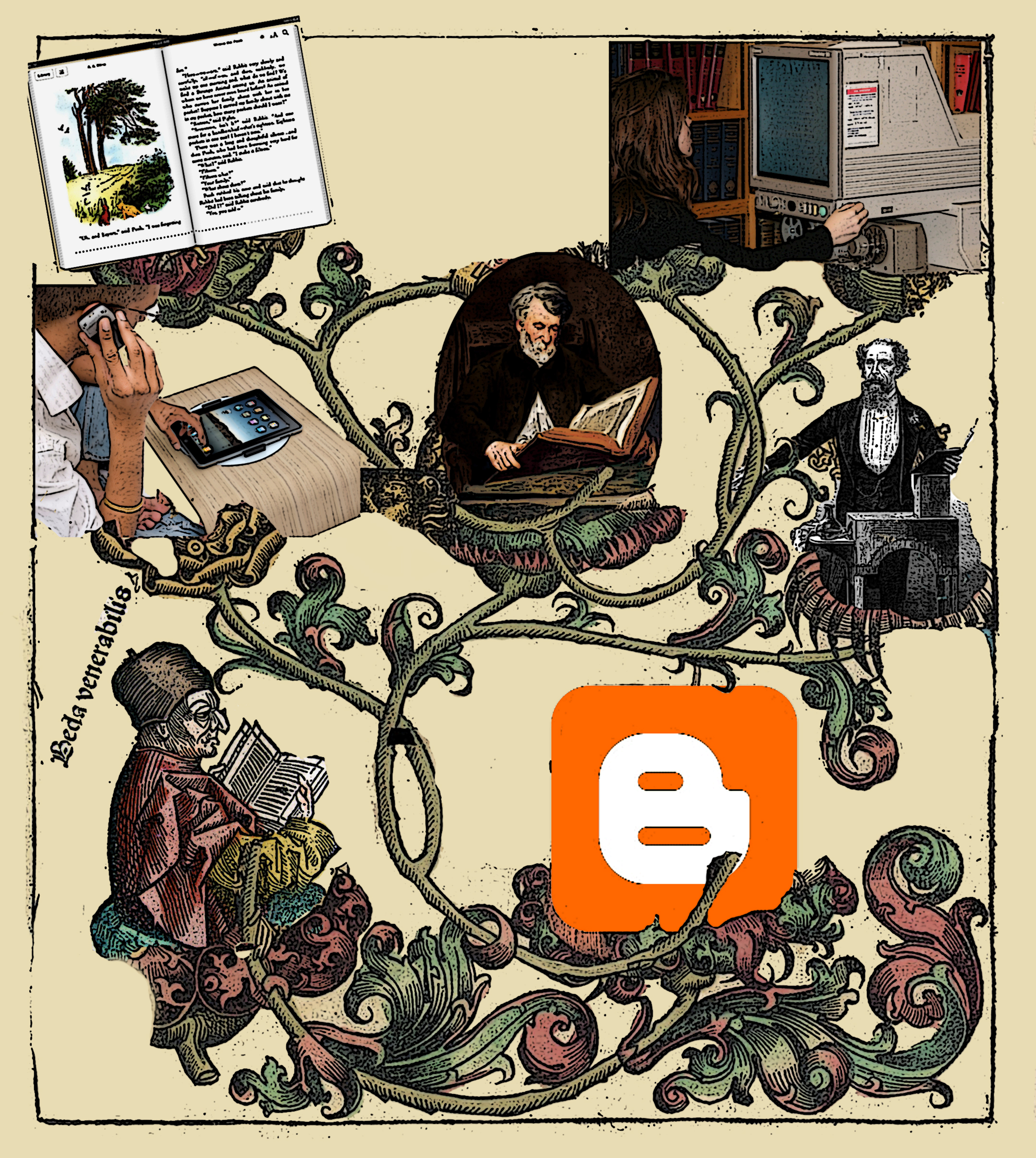Bloggers of the World Unite: Rare Book Bloggers and the Links They Build
This is a collaborative post by Brooke Palmieri and Daryl Green and can be found cross-posted on both of their blogs (8vo and Echoes from the Vault)

In August 2011 Brooke Palmieri [BP] wrote an entry over at her blog, 8vo, about a discovery she made while cataloguing a book for Sokol Books Ltd: an unassuming copy of an incunable on the authority of the pope that turned out to have been owned and heavily annotated by one of the premier among chroniclers and bibliophiles of the 15th century, Hartmann Schedel (best known for his “Nuremberg Chronicle”). The discovery dovetailed with the release of Sokol’s Catalogue 59, where it caught the attention of Daryl Green [DG], Acting Rare Books Librarian (Rare Books Cataloguer at the time) of the Special Collections Department at the University of St. Andrews, who also happened to be a follower of Brooke’s blog. Daryl, also the chief editor of St Andrews Special Collections blog Echoes from the Vault, had seen the catalogue and had gathered nominal support for purchase from his departmental colleagues, however, for a book this expensive, wider institutional support was needed. Therefore, the rare books team began circulating not only the seller’s description of the book, but also links to Brooke’s blog which told the story of this book and how it came to be on the open market. The support from the relevant academic departments (history, divinity, philosophy and art history) was unanimous and the book was purchased thereafter.
After this transaction, these two bloggers, working on opposite sides of the country, met by chance at the launch party for the USTC database held in Edinburgh last year, and quickly began to postulate on the role of the blog in the rare books world. What follows are some of the summaries of the ideas and criticisms from multiple conversations held around individual blogs and on the wider theme of blogging and its place in the rare book sphere, told from both the private bookseller’s and the institutional collector’s perspective.
I. Why rare books blogs are important
BP: In this instance blogging played an unlikely role in a very standard process of institutional acquisition: in order to buy a book, permission is necessary, and in order to get permission, a case needs to be made for the importance of the book. It’s not unlike agonizing over buying a pair of shoes, only the process is distributed across staff members for efficiency’s sake. I didn’t know it at the time, but my entry about Schedel’s copy of an otherwise common legal treatise that was floating around the internet made a case all of its own for the good folks of St. Andrews University Library.
St. Paul’s Churchyard has gone global: and just as London Stationers had their signs of Bear, of Star, of Pied-Bull, to identify themselves and to welcome, Booksellers can use websites. Blogging is especially important for booksellers who do not occupy a storefront as a way to see and be seen, for people looking to get rid of books as well as collectors. But it also makes sense as an alternative resource: just as there are aural learners and visual learners, there are those who look for books in printed catalogues, and those who search online.
DG: Grant providers such as the NEH, the CLIR Hidden Collections Program and the Andrew W. Mellon Foundation have been pumping money into libraries for the cataloguing of backlogs of material found in rare book and special collections for the past five years. These grants are providing the funding to bring in, or train-up, staff to catalogue, classify and collate these collections in an effort to ‘open the doors’ and extrapolate collections’ full potentials. This means that dozens of new cataloguing projects are coming on-line in the States and in the UK (to a lesser extent) each year, and with them come cataloguing jobs and more opportunities for new professionals to get the hands-on experience and training with rare books. There has never been a time of more activity in the institutional rare book world, especially as the curators of these collections are realizing that their work is one of the defining elements of a University’s identity in the world of the ever-more homogenized University Library. However, the sexiness of the job (which I describe to my parents as “book archaeology, or doing things like Indiana Jones, only with books and minus the large boulders and murderous Nazis”) can be lost in the creation of the prescribed catalogue and very rarely do the people (who are often the first ones to pick any given book off of a shelf in a long, long time) get to tell their stories and convey their every day excitement. Setting up a blog to run alongside these new projects that are putting together old and rare books and burgeoning professionals is not only one of the easiest ways to get your inevitable “new finds” out there, but it is also a very useful method of recording people’s initial reactions when working through all of this material.
 II. Why blog about old or rare books?
II. Why blog about old or rare books?
BP: In fancying itself a science, descriptive bibliography has always avoided sensationalism. This might be due to the fact that most things considered sensational are also considered low-brow, page-three, “hack work”. But taking a book of historical interest and talking about it in a less formal medium doesn’t cheapen its significance at all. It just puts it into a less formal medium.
I’m not saying that the standards of cataloguing should change so much as give a warm welcome to some complementary action. I’m saying that you can do all your blogging around town, and still take your shoes off before you come through the door. A blog lets you have it both ways: excess, without violating the sanctity and precision of professional standards. Blogging about excesses and behind-the-scene details is a way of advocating for the importance of books to new audiences. In a technological sleight-of-hand blogs make it possible to avoid mere specialty in favour of accessible expertise. In the most prominent words on Simon Beattie’s excellent website: blogs make it possible to sell “The Books You Never Knew You Wanted”.
DG: In any given month, a full-time rare books librarian or cataloguer will have worked with dozens, or even hundreds, of books deemed ‘special’ enough (i.e. old, rare, racy, falling-to-bits, or locally important) to be put aside in a rare books or special collections library. Each of these books have a story to tell, and it is the cataloguer’s job to distill the elements of each individual book’s history into the most concise description possible to make an accurate, but not too verbose, catalogue record. This process, like most others in the library world, comes with its own set of prescribed and detailed rules which assists in the creation of a uniform and fully indexed catalogue that is the first port-of-call for library users and researchers. However, the work that we do as rare book cataloguers, sellers and enthusiasts is 90% Sherlock Holmes and 10% Fredson Bowers: the behind-the-scenes story of how a cataloguer found out what bookplate belonged to who — how that person related to a signature found on the title page of the book — the potential story of how that book changed hands — how that book relates to other books in a collection, can be lost in the indexing, classifying and processing and rarely makes it into our finished catalogues.
The ability to express fully the amazement of the job that we do can be realized in the blog format. Cataloguers and librarians are in constant contact with fantastic material, and , sure, some of it may not be of interest to the ultra-scholarly crowd, but recording a cataloguer’s or student’s initial reactions to having worked with a Nuremberg Chronicle or the first edition of Shelley’s Frankenstein, or, The modern Prometheus is just as important as finding out the more esoteric elements of any period of printing. It tells us why these books matter in this age.
III. What should you be blogging about?
BP: A blog (and the Twitter account you should link it to) is an opportunity for booksellers to create content. I have noticed many using these platforms to simply re-blog and re-tweet other content. And while that is one way to attract followers who are interested in your particular take on the Curator’s Code, there’s a point at which it’s recycling, plain and simple. And not the kind of recycling that helps the environment so much as add clutter to it.
The followers it can attract plateau very, very quickly. Your chances of being the first port of call for readers are slim: no one is going to find you, let alone click on you, if the first thing that comes up in their search is the original article from the Guardian you’re linking. But they will click your link if it offers a unique spin on their search topic, complete with pretty pictures, both of which you probably have. You’ve got to expand the vocabulary of algorithm culture, you’ve got to make things Google-able that aren’t. Moreover, if you make a cycle out of creation and recycling, the free PR you’re crowdsourcing for the people you re-blog and re-tweet about will hopefully do the same for you. The history of reading is a very imprecise and unfathomable study, but at least with the internet you know that if a reader likes your work they will often pass it on.
Emphasis on content creation also should trump self-promotion. As a student of bibliography I am told to let the books speak for themselves. It ain’t a bad business model. In a recent article in his blog column for the Guardian, Rick Gekowski argues that there are more perils than benefits to ‘courting the press’ to advertise stock (‘self-promotion’). Gekowski’s reservations are a little too specific to rule out blogging/press coverage/self-promotion altogether. The moral of his story is to double- and treble-check the legal status of books and manuscripts in your stock, not to hide those books from public view, because no matter where you keep them the legal grey area follows. Our example with Sokol Books and St. Andrews proves the opposite. If you look at my blog post, you’ll notice there’s no mention of the book being for sale, I only focus on the thrill of the hunt. Sure there is an element of self promotion in it, but there is a really easy way to give self-promotion a positive spin: promote the ideas, the books, not the fact that they are for sale. Trust collectors to get in touch with you when they want to. If they have found your article, they will be able to find your calling card.
One of the best bookseller-bloggers is Laura Massey over at Peter Harrington Books: just see for instance her eye for curiosities from the First Book on the Loch Nest Monster, Thomas The Tank-Engine Models and Flappers at Sea. Not only does her expertise range from leaves of the Gutenberg Bibles to children’s pop up books, but she has a way of combining text and image that invites anyone in, and nobody says it better than her when it comes to content creation:
“The best way to make an impact online is to provide unique content, and as booksellers we already spend a lot of time researching and writing, so it’s natural to progress with blogging that material. I particularly enjoy posting the unusual and interesting items we have in stock, things that people may not be familiar with and which won’t have big web presences. There’s certainly a hunger for this type of rediscovery online, particularly for antiques, printed and handwritten text, book bindings, photographs–the type of material that we may have less contact with on a daily basis than previous generations did. Blogging is now one of the best ways to contribute to the cultural discourse, and I like to think that, in addition to raising the profile of the shop, we’re also increasing the amount of knowledge that’s available in the world.”
DG: The excitement that bubbles in a rare book library when a cataloguer finds an inscription of significance or a previously unrecorded book is tangible. It is the same kind of electric energy you can get when working with students or interested researchers. It is this initial connection, the visceral realization that you see come across a reader’s face as they realize they are handling something that was crafted 500 years ago, or was once held and read by Pope or Johnson or Woolf or Wells; that is why we do our job and that is the ‘magic’ that I hope to convey when blogging. The kind of energy that comes from a researcher’s first contact with an important rare or old book shouldn’t just be limited to the workroom or the classroom; blogs should help to populate search engines with photographs and indexed terms which bring the casual browser in [virtual] touch with these wonderful items that we have been entrusted to work with. Most library catalogues aren’t crawled or indexed by the major search engines, and so much of the minutiae that we include in a descriptive bibliographic catalogue record is behind a virtual closed door. The blog format gets that information out there. It liberates the information that is laboured over in the cataloguing process from the catalogue.
A good rare books blog has two key elements: commentary or content and images. Images are so important for these types of blogs, because, for many, these things first attract our visual senses and are stumbled upon by accident. Images from rare book blogs get Tumbld, Tweeted and Pinned by interested readers and casual browsers alike, these things are getting shared… who can say who will be interested in a reverse sheep binding, or the inky fingerprint of a 15th century printer? We should be blogging about what excites us, what might be interesting to a reader or something that you’ve worked with that is hardly talked about online. For example, some of the most popular and random search terms that bring readers to my blog from search engines include: “Albert Robida,” “manicula,” “dos-a-dos binding,” “17th century playing cards” and “Florida crocodile”. All we can do is put information out there as accurately as we can and hope that our voice sounds out in the crowd.
Rare book blogs range in level of commentary: from the very deep, scholarly works to the casual, “hey, look what I found today” style. All of these work, as long as you are writing original content and are open to having a discussion on-line and out-in-the-open about what you’ve written about. Terry Belanger, in a recent promotional video for the Rare Book School, said that “Most collectors want to talk about their collections, most friends of collectors don’t want to listen,” but I think that if we, as professionals, talk about what excites us about these thing in the open, on the web, more people will find out about these things, and more people will listen. Scholarly and trade conversations have been locked up in print publications and don’t serve the new generation of potential users of rare books or certainly the casual web surfer who stumbles upon an image of a great rare book. Previous correspondence between sellers, collectors, librarians and researchers are full of information about where copies of a certain book were and in what state. Having a conversation, out in the open, where it can be read and seen by all is key. We shouldn’t be afraid to say that we don’t know something or even to get something wrong. Confronting a known community with a question which stokes their minds will ultimately produce results.
–BP & DG



[...] is a collaborative post by Brooke Palmieri and Daryl Green and can be found cross-posted on both of their blogs (8vo and Echoes from the [...]
Great post, thank you. It helped clarify my thoughts on rare book blogging.
You're welcome Katie, glad we could help - I think both of us hope to see more rare books blogs coming online soon!
Reblogged this on Collections in a Cold Climate and commented: Just a quickie (deadlines loom!), this post is wonderful example of ways blogs can tell stories of objects and bring them to life - and make their case. I've often thought of blogs as supplementing library catalogue records, but not really made the leap to realising they can do same for antiq bookseller records ... Hooray for blogs and bloggers!
Thanks Alison, for the re-blog, we're happy for this to get shared with a wide an audience as possible! Indeed, I think, at times, that the work that I've done blogging has raised as much profile on a book or collection as cataloguing. Perhaps a hybrid role is the way of the future: a Cata-Blogger!
I was so thrilled to see this - I've just started my own blog re: one particular rare book. Wading into the waters of descriptive bibliography on a blog is daunting, but I'm very excited about the potentials of this format. Thanks for sharing!
Thanks Jillian, your blog is looking grand and it is a really interesting idea to focus down on one particular book. I'll make sure to add it to my feeds!
This is a great discussion! I haven't actually finished reading through this yet, but I got excited and wanted to share my favorite example of how blogs create added value for items/collections in special collections. I've been following the blog for the Robert L. Van Nice collection at Dumbarton Oaks for a while now (http://robertvannicearchive.wordpress.com/ - Van Nice was an architect who conducted a massive study/survey of the Hagia Sophia over nearly 50 years). In addition to being an endlessly fascinating peek into processing a large collection, it will be an invaluable resource for potential researchers once the project is completed. It highlights unique discoveries, basic materials, and contributors to or individuals mentioned in the collection (not to mention the beautiful photographs and architectural drawings they post from time to time). That of course is a very in depth example- one blog dedicated to just one collection- but I'm excited about the potential of even high-level posts on a variety of items (especially for smaller institutions that don't have the time/training/funding to delve into EAD and the like). Thanks for this!
Hi Jessica, thanks for the comment and your excitement! The Van Nice collection blog was unknown to me, but it looks like a very solid blog with a lot of great conent. These kinds of project based blogs are great because they allow discovery of the material outside of the main catalogues and they add context and real ephemera to the collections themselves!
Nice work, guys!
Thanks Bill! Looks like you're gearing up to start up your own blog, is that true? If so, will it be focusing on readership and marginalia?
Reblogged this on EticaProfesionalInformacion.
Reblogged this on Sarah's Desk and commented: Rebloged! This is a great post about the role of blogging in the rare book world. My
Reblogged this on JANINEVEAZUE.
[...] of the contributor. Members of the group keep in touch and help each other out. In the post Bloggers of the World Unite, the authors Brooke Palmieri and Daryl Green (a bookseller and a librarian, writing jointly) state [...]
Really enjoyed this joint post Daryl and Brooke - hope you'll share more from your IFLA talk, Daryl, for those of us who can't get to Helsinki...
Hi Suzanne! My paper has been uploaded here, along with most of the others: http://conference.ifla.org/ifla78/session-87 And I'll see about sharing it along with my presentation on the blog here after the fact!
HI, I've just found your blog through this month's article in Broadsheet - It's so helpful to find someone talking about how to make great content that excites people from a cataloguer's point of view. I've recently started blogging as part of my new project archivist role, and your stats blew me away, thanks for sharing what you've learnt - I'm going to go read more of your site now!
Hi Justine, thanks for visiting and commenting! I love York, I spent a few years there and it is a very special place with a fantastic archive, you are quite lucky! Welcome to the special collections blogosphere!
Thanks, great post. Another aspect to point out is that book blogs on specific book fields can create a gathering place for those interested in that area. We have a blog http://judaicaused.blogspot.com/ that is focused on a rather specific field but we have found that it brings in loyal readers and creates a place of discussion for people of similar interests
Awesome post on rare book blogging, I must say! The joint post by Daryl and Brooke will surely be enjoyed by many of your readers. The unique thought process of both of you have come out nicely. Thanks for sharing it with us.
Rare bookselling & blogging is a great profession. Unlike the new books straight from the publisher - where there are no doubts or concerns of the price (the RRP is right there); rare books on the other hand, not only require a true love of books, but an amount of knowledge that few people probably actually know. A rare bookseller & blogger needs knowledge in many fields to be successful; including a vast knowledge of their chosen book subject/specialty. You can't write about what you don't know!
Reblogged this on jamesgray2.